Galleries: Cathedral Cabinet, Gertrude Glasshouse
Exhibitions: Victoria Stolz, no external; Francis Carmody, A Relic Remains
There is a pull across the mismatched grids of the urban metropolis. From the purpose-built contemporary art space of Gertrude Glasshouse to the appropriated commercial window of Cathedral Cabinet, the allure of myth and meaning is the preoccupation of two recent solo exhibitions by Francis Carmody and Victoria Stolz.
Carmody’s A Relic Remains at Gertrude Glasshouse pairs the incidental with the cosmic, the banal with broader earthly concerns, and contemplates humanity’s continued impetus to do so throughout time. Stolz’s offering at Cathedral Cabinet is, on first glance, a different beast entirely; no external is a small painting series in which composition, and the architecture of the cabinet-cum-gallery itself, seemingly work to tightly contain movement and meaning. On second glance, these works are evasive and refuse to be pinned down. The viewer’s innate desire to attach meaning to the symbolic is co-opted into a staged drama of questioned perception.
A never-quiet looking
The trio of paintings that comprise no external all bear evidence of washes and glazes, shifting layers, reworkings and reconfigurations. These works are seemingly caught in moment of becoming yet consistently committed to Stolz’s palate of inorganic earth-based pigments, flooding alizarins and the seeping slippage between yellow and green. Ochres are combined with synthetic cadmium and phthalo hues resulting in a muddy iridescence; an unctuous kaleidoscope that puts in one’s mind the moist undergrowth of a drenched rainforest or the blurry blooms of a half-healed bruise. The rainbow is not a far-flung ethereal phenomenon here — a shimmering portent in the high reaches of the firmament — but a close, earthly occurrence: heavy, opaque and drenched in a filmy slick.
Stolz’s selective palate melds the synthetic with the organic indiscriminately; there is no moral imperative here to place the “natural” over the “artificial”, nor a hierarchy that preferences pigment arrays from centuries past. no external also refuses to delineate between the abstract and the representational. The trio of paintings hover somewhere between the mimetic and the non-figurative, existing in a liminal space that throws the act of looking into question and demands that perception be continually reassessed.
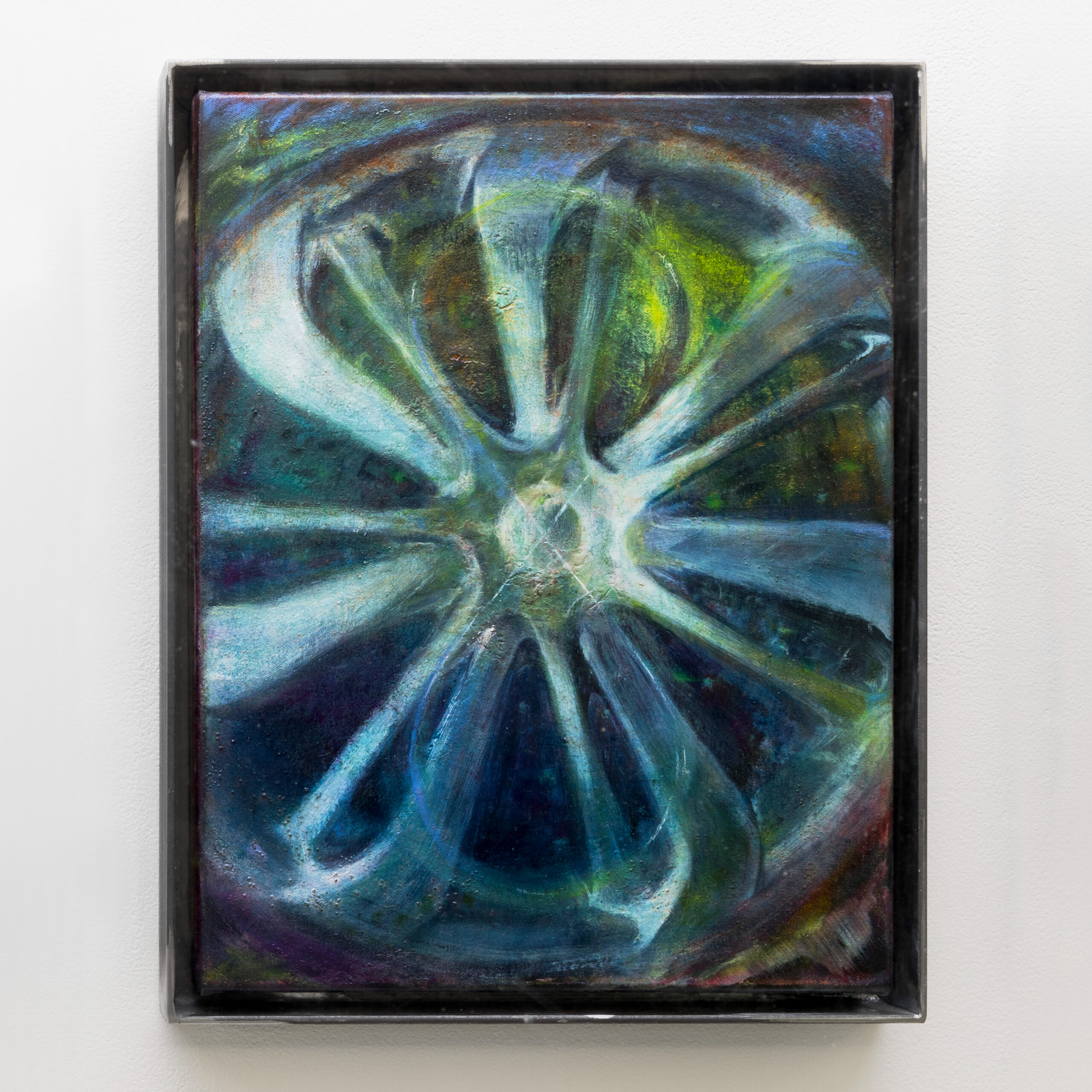

In 1+1, a sequence of dark portals punctuates an oozing mossy yellow wall flecked with darker veiny clumps. These portals could depict a night-time road glimpsed through a windscreen, a mysterious deep-sea submersion or another equally eerie scene. By continuously retreating and evading full actualisation, these potential vignettes lead the viewer’s desire to affix meaning to shapes and colours back into itself. Overlaying this composition is an ever-turning mass of half-seen swirls and arcs, a cursive flourish materialised into a python’s purple twist. These figure-eight turns, seemly concerned with the movement of the brush rather than the actualisation of a mark, are mirrored in 1+1’s companion painting, centre. Here a looping infinity symbol is traced like the two blades of a propeller over a cropped circular composition comprised of blues, yellowy greens and cool powdery white tones that are suggestive of metal in motion. We could be seeing the blades of a fan, a hubcap or the symbolic imagining of a celestial wheel.
Explaining the impetus behind her latest paintings, Stolz spoke of centre’s nod to the symbolic language of the Tarot. The Wheel of Fortune, which can represent good or bad luck depending on whether the card is drawn upright or in reverse, is a matter of perspective. The intriguing symbolic language of the Tarot provides, for Stolz, a comprehensive system of symbols upon which the reader (or viewer) can project their own desires and preoccupations. A Tarot deck, like a language, provides a suite of fixed and inherited cyphers upon which we hang approximate meanings to share with other readers. Which begs the question: what is it that symbolic systems cannot contain? What is it that falls between the many gaps of a language and cannot be expressed?
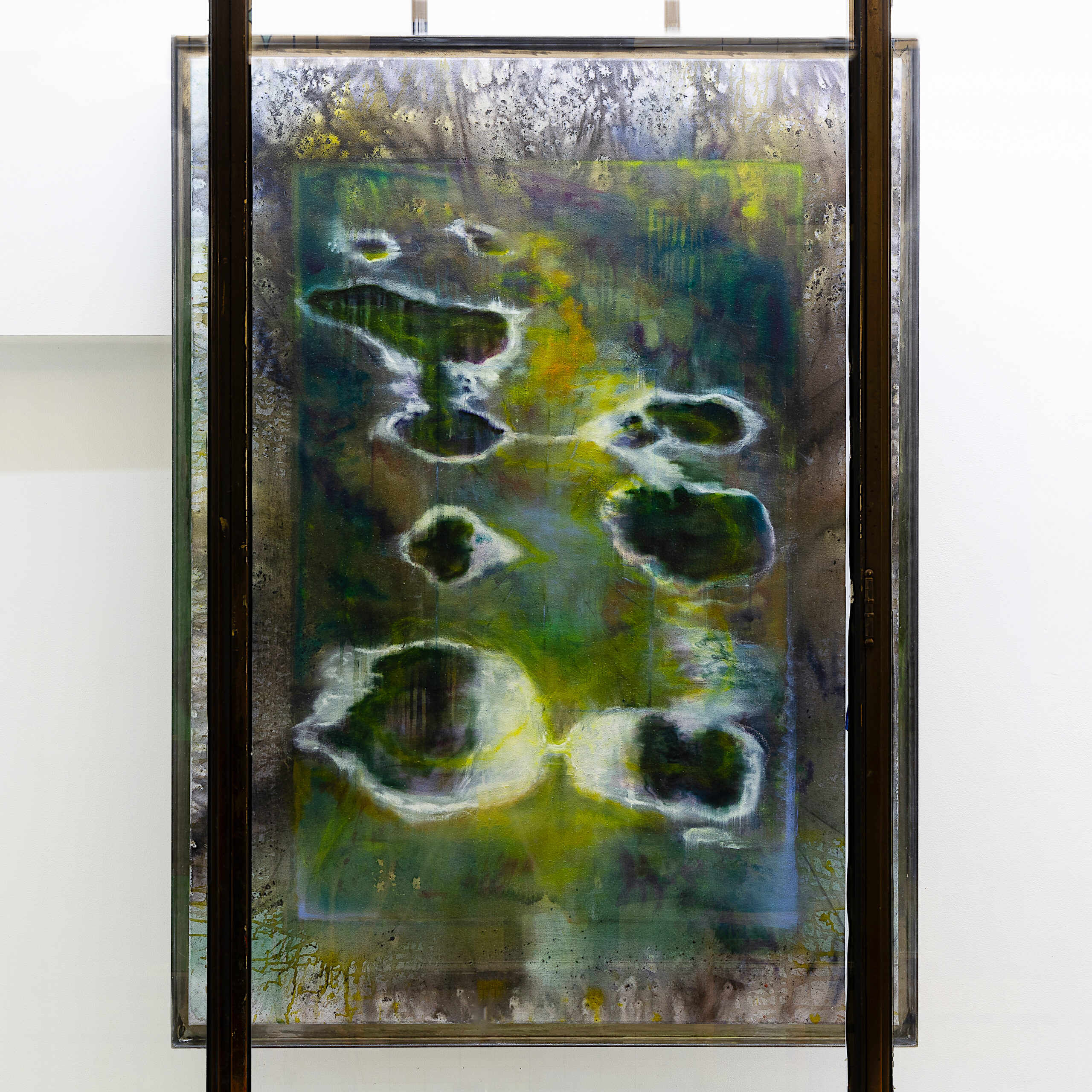
It is precisely this question that the largest of no external’s paintings, partial veil, revels in. Employing a preferred compositional trope of Stolz’s — the outline off-set boarder — this large piece hangs from the cabinet ceiling in a cleverly engineered steel frame and armature. The internal frame of partial veil depicts what could easily be an abstract composition of large, irregular spots outlined in white, a series of dark welts, the iridescent eye-marks on a butterfly wing or peacock feather or shallow puddles of water caught in late afternoon sunlight. Rivulets of a dull, earthy violet drip from the painting’s central demarcation outward in all directions across the relatively paint-free surface of the work’s interior border. The inner image is slicked with a yellow-green glaze, adding complex colour notes to the darker areas of the painting’s surface.
Stolz states that she based the painting on an image of water-filled potholes, setting out to paint something that reflected the viewer’s gaze. In attempting to discern what may be contained in the watery depths, the reflective surface obscures and defies the viewer’s search for meaning. Ultimately, there was nothing in these potholes but water. Like the Tarot’s “empty” symbolism that can be meaningfully filled with the reader’s own preoccupations and circumstances, the paintings of no external invite input from both the viewer and the architectural context more broadly. This is perhaps most poetically illustrated when gazing at these paintings through Cathedral Cabinet’s reflective glass exterior, we see the lime-green LEDs of the Subway sign echo the series’ palate.
An endless pulling
In perhaps a more direct interaction with the surrounding architecture, Carmody’s A Relic Remains takes as its starting point the steel-grided glass of Gertrude Glasshouse’s front window. This grid, like the graticules overlaying a map, is reminiscent of the latitudinal and longitudinal lines that grip the earth’s globe in the cartographic imagination. Technologies like cartography assist and restrict thinking. The underpinnings of cartographic science are deeply colonial and partial in nature and yet this navigational system is ubiquitously deployed and relied upon in the mobile world which we inhabit.1 It is among these big ideas concerning the impartiality of technology and “progress” that Carmody stages his work. A Relic Remains considers both scientific systems of knowledge and mythic concepts of the cosmos. It deploys these as the unseen players (biased and with their own flawed agendas) that have influenced the cosmic drama up until this point. And it is between these colossal ideas and the banality of a toothache — between the microscopic and macroscopic — that the lens of this exhibition continuously shifts.
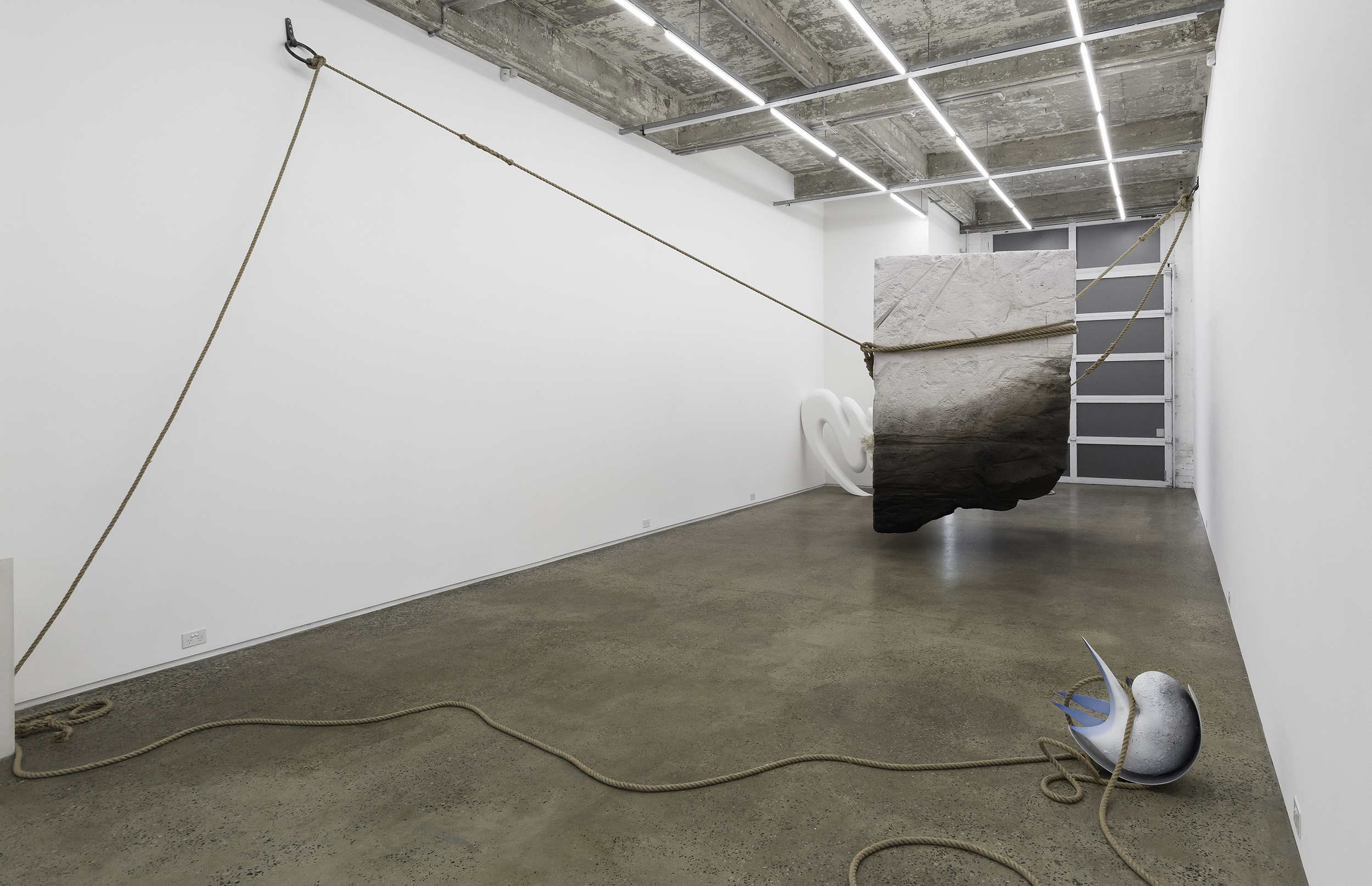
Through the evocative gridded glass of Gertrude Glasshouse’s front window, a celestial spectacle is staged. At the centre of this drama a huge chunk of suspended polystyrene, scored, chipped, and coloured with iron, charcoal, quartz, latex and paint, hovers above the gallery’s concrete floor. The significant size and seemingly precarious levitation of what at first appears to be a monolith of rough-hewn stone is arresting. This form — dull white at its crown and a brownish black at its jagged, tapering base — shifts from a decaying tooth to a stone tor, playing with scale and the audience’s expectation.
This is not your average giant molar however, but a tooth of titanic origins and epic proportions. Artfully trussed-up in a dun-coloured rope, it appears to be hoisted aloft by two stylised creatures at either end of the gallery: a goat and a crab. The rope, entitled Incantation for a Toothache: Removal, is spliced together to form variation in the entire length’s thickness. Passing through claws, over horns and around teeth, it is anchored by iron rings to the wall, and manifests the dramatic tension that binds the installation together. It appears that we have walked in on a celestial dental procedure just as Atlas’ rotten tooth is yanked free by the embodied tropics of Capricorn and Cancer. The scene is at once grandiose, intriguing and hilarious.
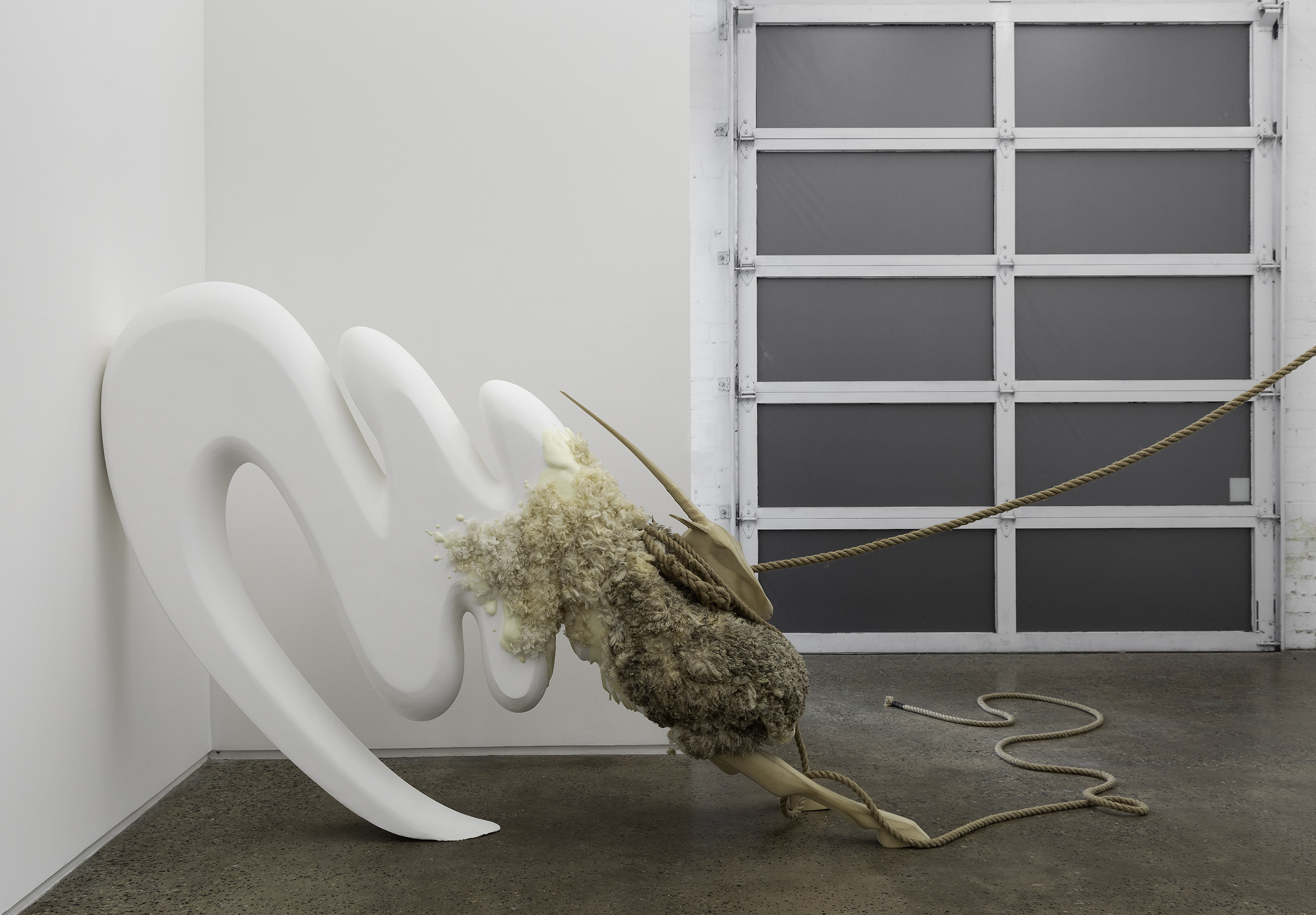
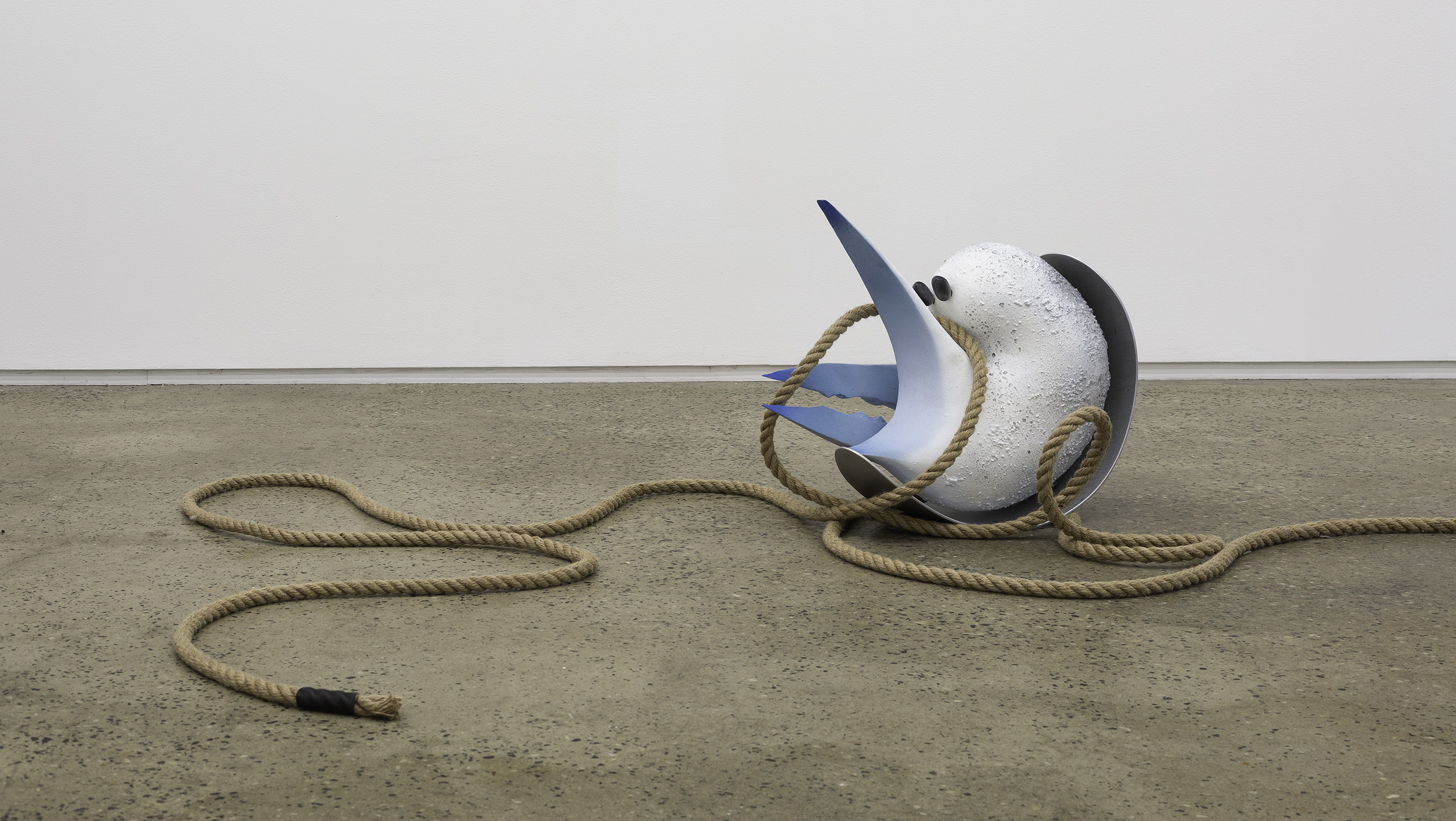
There is a theatrical element to this mythically inspired ensemble. But looking closely at Tropic of Capricorn Persistent and Practical there is also a pull to the material element here and an impetus to break things down to their simplest state. The materiality of the blond MDF, creamy expanding foam, ice-white plaster and mottled ram’s fleece are artfully comingled. The result is a form that doesn’t deny its compositional elements, but is also able to embody the coiled, spring-like energy that is necessary for it be read in the broader narrative ensemble. The Capricorn is a composite beast, after all.
A Relic Remains is a playful splicing of both technologies and materials; of mythic and scientific stories. The scene that results expresses the fallibility inherent in notions of progress, without teetering into the abyss of a doomed apocalyptic narrative. Carmody both articulates and complicates a moment in which global-scale fears overlap with the deterioration that our own bodies inevitably play out.
1. The ‘ground zero’ of longitudinal lines, the prime meridian, is based in Greenwich in the United Kingdom. All longitudinal meridians are calculated by measuring from this location.
Skye Malu Baker is an artist and writer currently based in Naarm/Melbourne.
This text was commissioned through the Emerging Writers’ Program. An annual collaborative project, from KINGS and un Projects, that supports critical arts writing, fiction, poetry, experimental, cross-genre and digital text forms. The Emerging Writers’ Program provides professional publishing opportunities and fosters dialogue between artists and arts writers. Each emerging writer in the program receives critical feedback and editorial assistance from KINGS and un Projects personnel.
Supported by Creative Victoria, City of Melbourne and City of Yarra.
